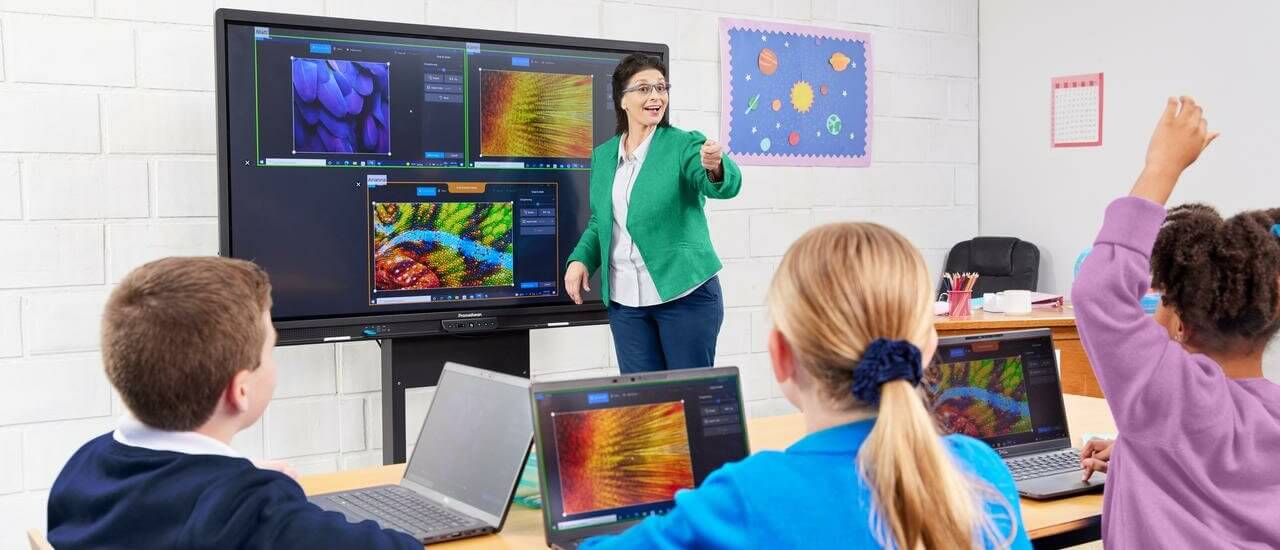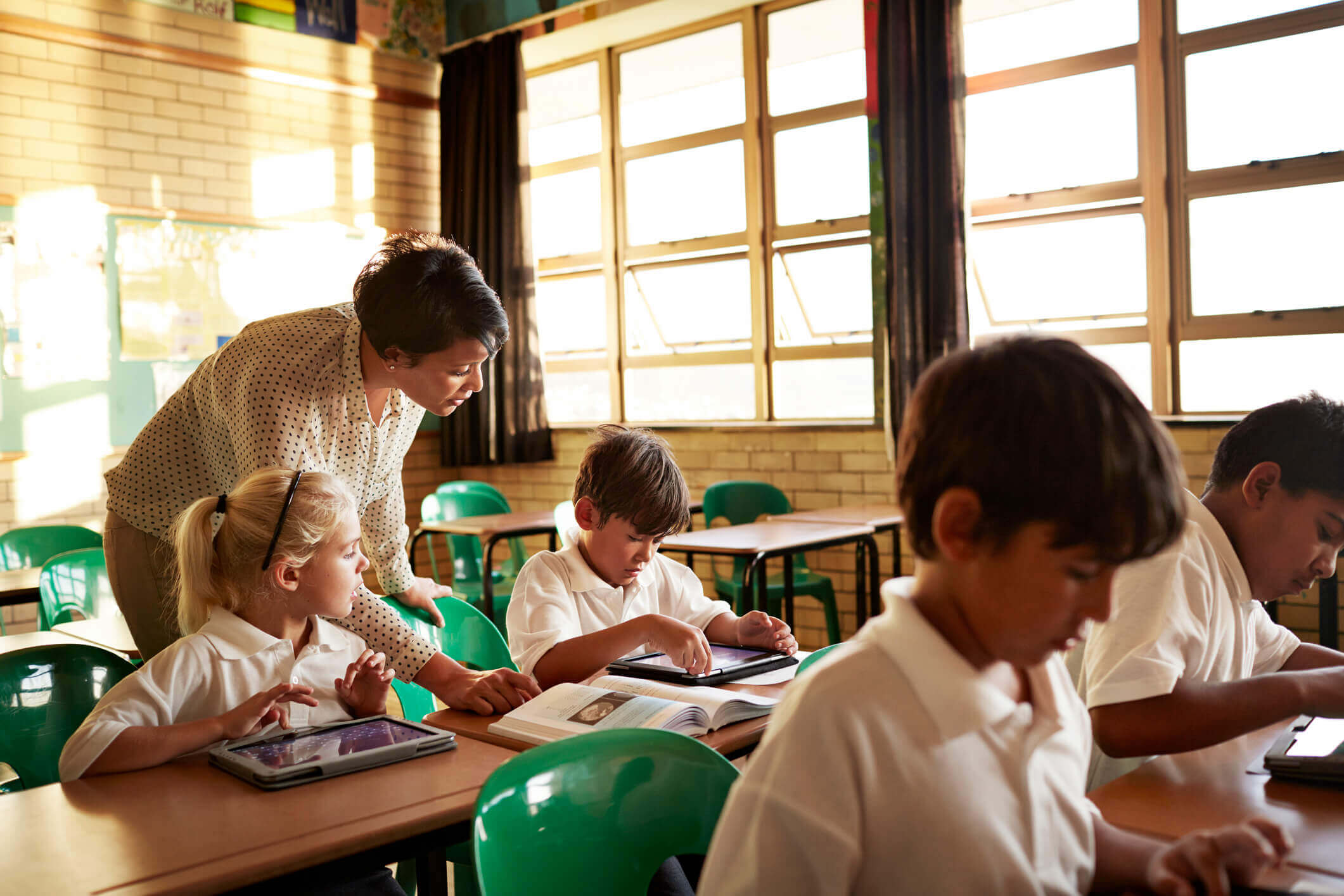Published on November 22nd, 2023
Improving Teacher Knowledge of Technology in the Classroom
12 minute read

With technology advancing at such a quick rate, it can be difficult to keep up with the latest edtech and software. Adjusting to these changes and maximising the use of new devices and software can be equally as challenging.
There are many benefits to staying up-to-date with the latest innovations and, where possible, amending teaching strategies and lesson plans to incorporate technology in the classroom.
Here, we explore how school leadership teams can improve teacher’s knowledge of technology, the reasons some teachers may resist new tech and the advantages of embracing innovative new equipment.
Classroom technologies: An overview of what’s available
Before we explore how to improve teacher knowledge of tech, let’s familiarise ourselves with the edtech devices and software typically available to enhance teaching and learning experiences.
- Interactive whiteboards: These displays allow teachers to use technology to present digital content and engage students with touch or pen. By using an interactive whiteboard in your class, you enable students to write, draw, and interact with content on the board, which helps to create a dynamic learning environment.
- Projectors: When used in conjunction with interactive whiteboards, projectors can benefit student learning by making lessons more engaging and interactive
- Tablets and laptops: These devices are ideal if you are looking for portable computing solutions for delivering lessons and accessing resources. Similarly, this tech can support children with SEND who may not be comfortable using a pen or pencil.
- Educational software: Various types of educational software can help a teacher carry out their role, from basic administrative tasks, examination tasks or lesson planning. There is even software that caters to specific subjects and learning objectives, offering interactive lessons, quizzes, and multimedia resources.
- Video conferencing tools: Apps like Zoom and Microsoft Teams allow you to teach classes remotely, connect with guest speakers, and host collaborative projects, regardless of where your students are.
- Audio enhancement systems: Especially useful if your class includes students who are hard of hearing, classroom audio systems ensure that all students can listen to instructions and engage with course materials.
- Online resources: Using the internet, you can access a wide range of educational websites and digital resources to enrich lessons and ensure your students have a deeper understanding of the curriculum.
When you integrate it into the classroom properly, technology can engage students, vary learning experiences, prepare students for life after school, and streamline administrative tasks.
How to improve teacher knowledge of technology in the classroom
Changing your approach to teaching can be daunting, and it might be challenging to know where to start. To help you simplify the process and pass on what you have learnt to your students, here are a few ways to streamline the process:
1. Get involved
As part of continuing professional development (CPD), teachers should keep up-to-date with new technology. For example, they could do this by reading tech blogs and keeping abreast of the latest topics and developments or connecting with educators on social media sites like Twitter or LinkedIn to see what tech is being used and how.
2. Work with colleagues
As well as learning independently, teachers should take time to understand how their colleagues are using technology to enhance lessons and see if they can utilise tech in the same way.
Additionally, you share any challenges and successes associated with implementing tech and encourage your colleagues to do the same – this information can be used to inform future training.
3. Exposure to technology
The best way to get used to new devices or software is to use it. Consistently using new devices or computer software will build confidence and reduce anxieties relating to new educational technology. To ensure all teachers have the same access to technology, encourage your school’s senior leadership team to run initiatives showcasing its importance.
4. Technological lesson plans
Integrating technology into lesson plans will reinforce teacher’s understanding and make them more tech-savvy. Teachers could even shadow one another to see how they incorporate technology into their classroom instruction for some tips.
5. Seek student feedback
Asking students how they think technology could be incorporated into their lessons is a good way of building your awareness of the software and devices teachers could be using. This also encourages pupils to participate actively in their learning, increasing student engagement and building a stronger rapport.
Top tip: if you’d like to save time in the classroom, you can set student feedback tasks as homework assignments for your class.
What are the benefits of using technology in the classroom?
If you’re building a case for your school to invest more in technology, here are six key advantages to having a tech-savvy:
- Enhanced engagement: Technology can help engage students and make lessons be more interactive through the use of multimedia content, videos, simulations, and gamification, all of which help to improve learning outcomes by capturing student’s interest.
- Personalised learning: Technology allows for adaptive learning, where content and pacing are tailored to the individual needs of students, helping them learn at their own pace and take part in different types of assessments to cater towards their specific learning style.
- Access to information and tools: The internet enables students to research, explore, and consolidate their understanding of various topics.
- Opportunities for collaboration: Students can use digital tools to collaborate on projects and assignments, benefitting teamwork and communication skills.
- Real-world skills: Regular interaction with technology can help students develop their technical knowledge and skills, readying them for further education and the world of work.
- Inclusivity: The abundance of resources available can help teachers cater to diverse needs, including supporting students with special educational needs (SEN) and help to engage children with English as an additional language, ensuring all kids have the opportunity to learn.
- Reducing the burden on teachers: Our latest State of Technology in Education Report revealed that teachers feel critically overworked and under high levels of stress in their roles. Edtech can streamline communications and enable students to learn more autonomously at times, thereby relieving teachers of some more routine responsibilities.
It’s important to note that while technology offers many benefits, its effective inclusion within the classroom requires thoughtful planning. Explore our blog for an in-depth look at the benefits of technology in education.
Why might teachers resist integrating technology into their lessons?
While technology can offer significant educational benefits, not all teachers may be enthusiastic about integrating it into their lessons. The reasons below may go some way to explaining why teachers could be hesitant or resistant to using technology in their classrooms.
- Lack of tech training: Some teachers may feel anxious about using technology they’re not familiar with, especially if they’re not entirely confident in their computer skills.
- Resource constraints: Technology can require significant investment. With insufficient funding and time at a premium due to staff shortages, teachers’ ability to integrate technology effectively may be affected.
- Concerns over screen time: Teachers may be concerned about increased screen time and an overreliance on technology, fearing it could negatively affect their development and overall well-being.
- Lack of awareness: Some of your colleagues may not see the value of using technology to enhance traditional teaching methods.
To alleviate these concerns, you should ensure that adequate tech training is given so teachers feel confident when using new technologies and software. Ongoing edtech upskilling support should be offered for teachers who may not feel entirely comfortable utilising technology.
Getting the most out of your classroom’s technology with help from Promethean
Technology in education has become an intrinsic part of the learning process, and it can make lessons more enjoyable for students and teachers alike.
One of the most valuable tools available to teachers is an interactive display, which can increase student engagement and appeal to their learning style.
The Promethean ActivPanel can help you uphold more traditional teaching practices, enabling kids to participate in handwriting exercises on the interactive whiteboard and group feedback sessions from the shared screen.
Discover ActivPanel first-hand with a free demo, or head to our Learn Promethean page for online resources and video tutorials to help you get to grips with our interactive displays.
Alternatively, you can check out Promethean reviews to discover how our technology has benefitted the student learning experience for kids worldwide.
FAQs
How do teachers use technology in the classroom?
Teachers can leverage many types of technology to enhance kids’ learning experiences and outcomes. This tech can be anything, from interactive whiteboards that allow teachers to present to their classes to specially designed software that can create tailored plans to help students learn at their own pace.
How does technology help teachers fulfil their role?
Technology helps teachers in numerous ways, from enhancing teaching strategies to completing administrative tasks and interpreting student data. Utilising technology and resources like the internet, teachers can expand lesson possibilities, simplifying concepts and investigating theories with more detail.
Additionally, teachers can use multimedia software to adapt lesson plans to individual learners and accommodate all learning styles – making education more inclusive and accessible.




